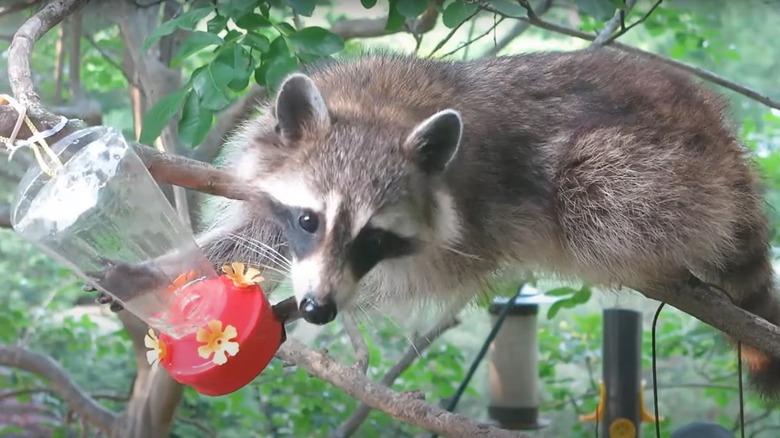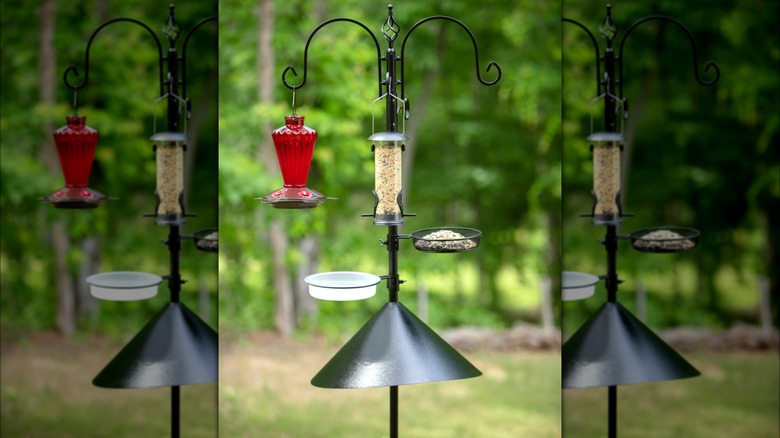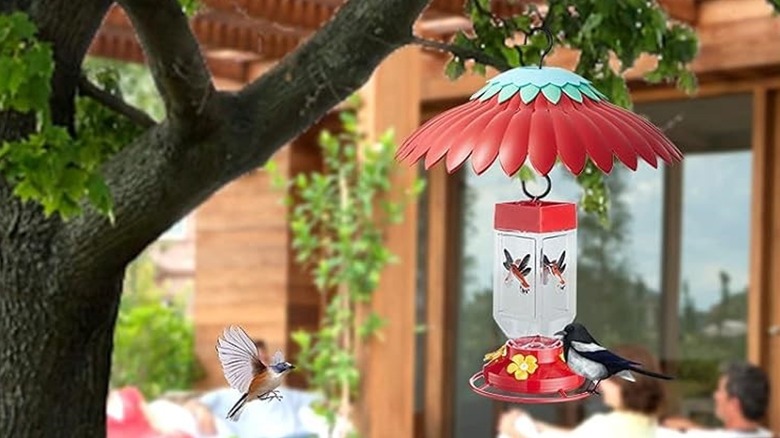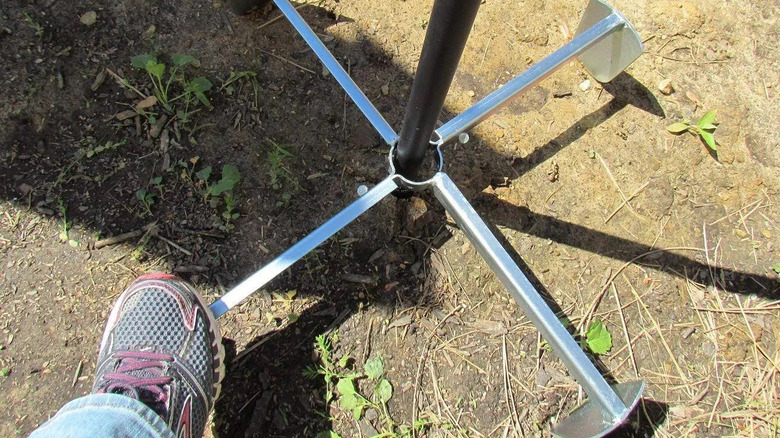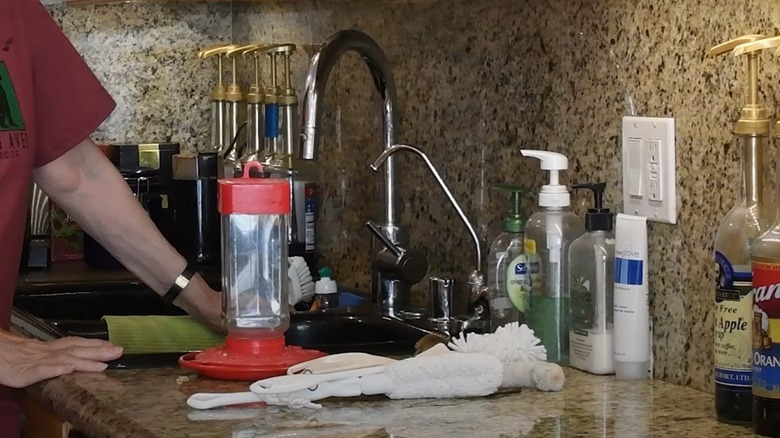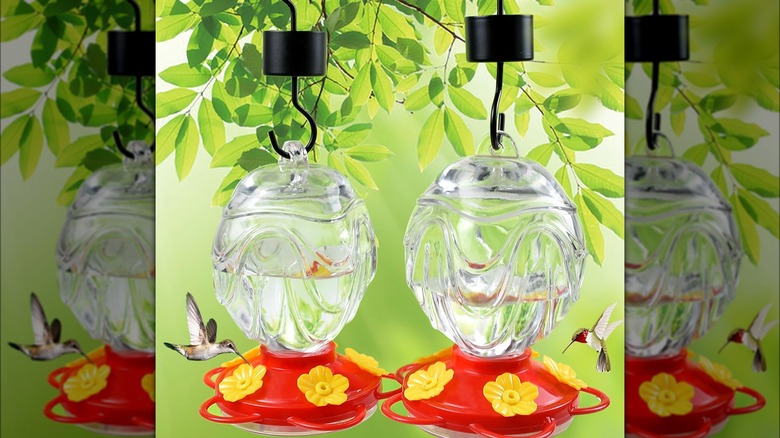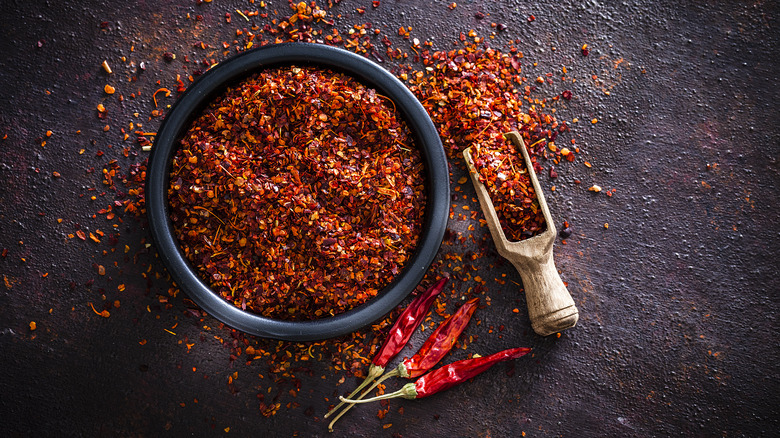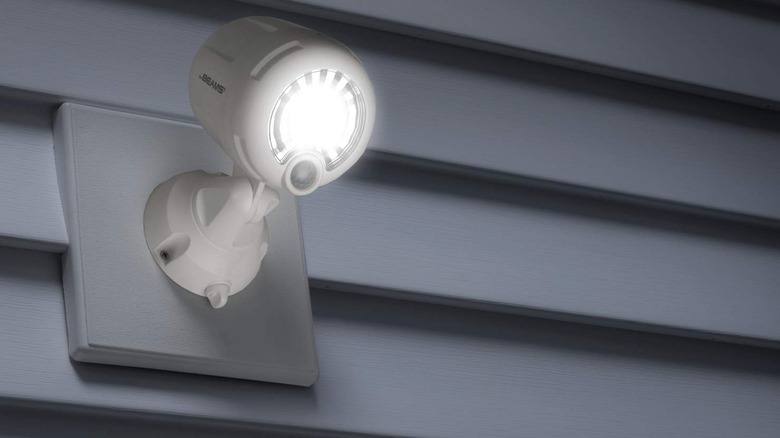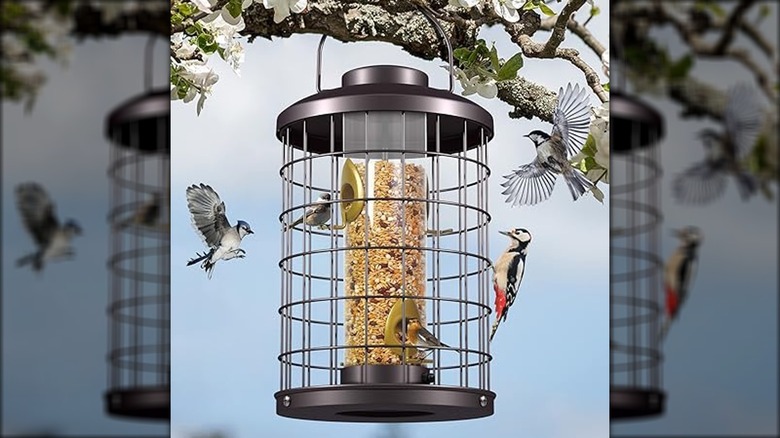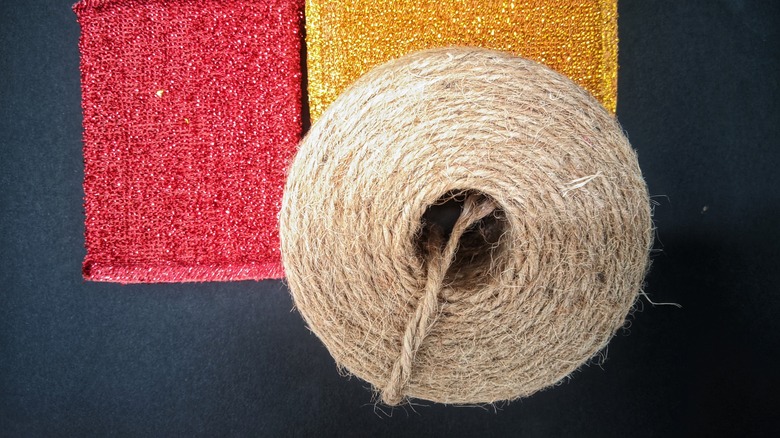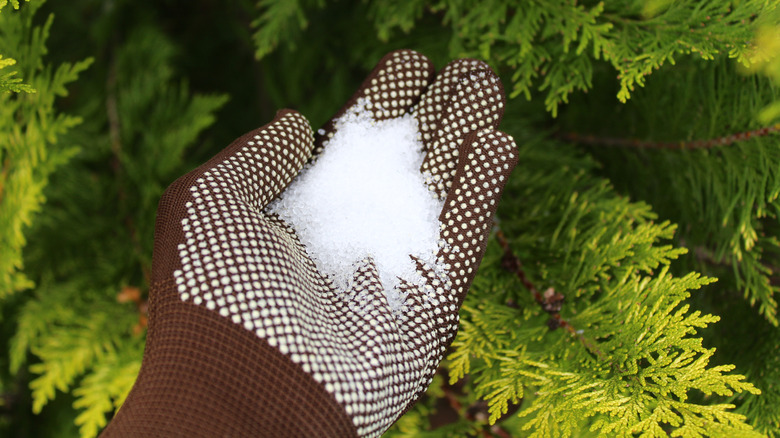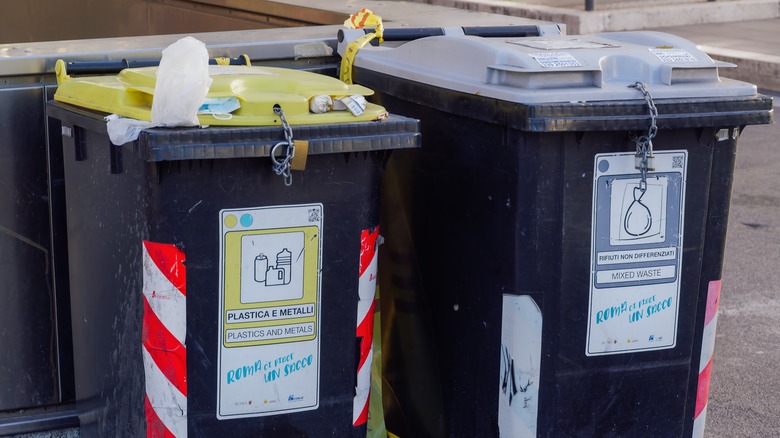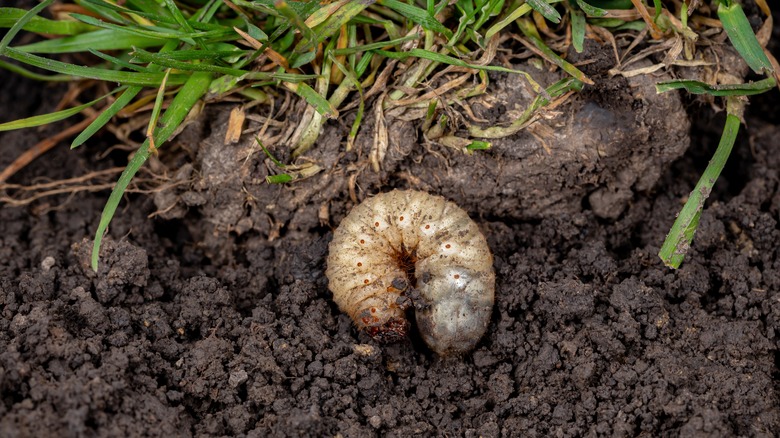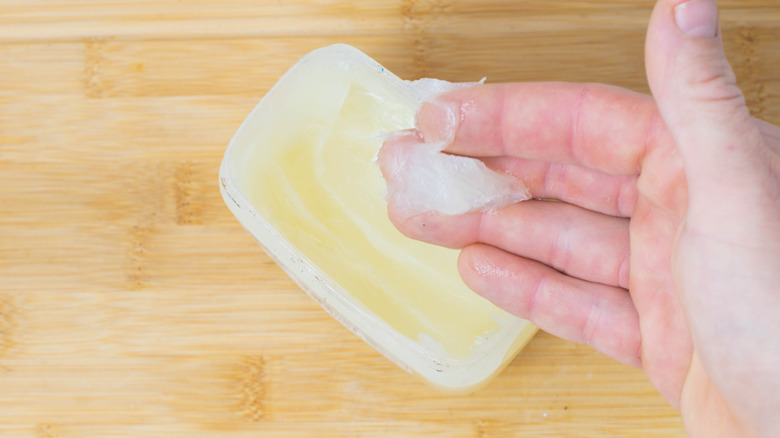13 Genius Tips For Keeping Raccoons Away From Your Hummingbird Feeder
We may receive a commission on purchases made from links.
Hanging a hummingbird feeder in your yard is a great way to welcome these majestic birds to your space. Watching them flutter their wings as they suspend themselves in flight is quite spectacular. Unfortunately, hummingbirds aren't the only ones that may be attracted to these feeders. Raccoons may also identify them as a good source of food to serve as a nice dessert after rummaging through your trash cans for their main entrée.
If the raccoons can access the feeders, they will. And, sadly, they're likely to keep coming back for more of the sweet nectar night after night. This will leave little left for your feathered friends, costing you money and resources. You'll end up having to buy more nectar than you budgeted for, and these furry pests might even break the feeder in their quest to get to the sweet-tasting water. Read on to discover how to keep these pesky intruders from stealing what is not theirs.
Add a raccoon baffle to the feeder pole
Raccoons are better climbers than you may guess. Hummingbird feeders hung on poles are not safe from these thieves. They can make their way up the rod, and once they've climbed up a bit, they'll either be able to reach to access what's inside the feeder or swat at it enough to knock it down. A pole baffle can be an effective solution for preventing raccoons from getting to the feeder.
These types of baffles work as a guard to block creatures from climbing up a pole. The raccoons won't be able to easily get around them or jump over them. After some time, they'll give up on trying to access the feeder. Cylindrical models, called torpedo baffles, are ideal for poles. You can also purchase wrap-around baffles if the pole design will make it impossible to slide one over the top. Look for a large one that is at least 2 feet tall with a 10-inch diameter. Otherwise, the tricky pests may be able to find a way around it. The smooth and slippery edges of these models can also help keep squirrels from stealing the food you leave out for the hummingbirds.
Try a hanging baffle for feeders hung from trees
Pole baffles clearly aren't going to be of use for feeders that are hanging from a tree branch or fence. Raccoons are often able to access feeders in these positions by jumping onto the top to get at the food or to knock the entire unit to the ground. Fortunately, a hanging baffle may be able to come to the rescue.
Like pole baffles, hanging baffles are designed to deny raccoons access to the bird feed. The difference between the two models is how they work. Rather than stopping raccoons from scaling a tall pole, hanging baffles prevent the pest from getting at the sweet nectar from above. As their name suggests, these models are suspended above the feeder. They have a domed shape and will rock back and forth, throwing off the balance of any creature that tries to jump on them.
Secure the feeders well so they can't get knocked down
If your feeder is on a pole, making sure that the pole isn't going to tip over easily is important. Using a stabilizer can help secure it into the ground. Stabilizers connect to the base of the pole and then can be stuck into the ground to anchor everything into place. In addition to the benefits they can deliver related to raccoons, they can also help keep the pole and feeder nice and straight for the birds when they visit your yard.
If a raccoon can figure out how to knock over your hummingbird feeder, it certainly will send it flying to the ground. One thing you can do to prevent this is to secure your feeders so they stay in place. One great way to do so is to try a solution clip. Available from stores like Wild Birds Unlimited, these special devices are designed to block the opening on select shepherd's hooks and pole system arms. The barrier they create makes it impossible for the feeder to fall off its hook without first removing the metal bar that is blocking the opening.
Don't leave bird feeders out at night
While it is not guaranteed that a raccoon won't stop by looking to scavenge during the day, they are primarily nocturnal creatures. Conversely, hummingbirds rest at night and are active during the day. This means that you could stop them from getting at the feeders if you bring them into your garage, shed, or house after dusk. Simply hang them up the next morning so the hummingbirds can continue to feed.
While this can be an effective solution, it will require a chunk of your time each morning and evening. If you don't realistically have the time to follow through with this idea, you could try changing the amount of nectar you leave out each day. Gauge how much the hummingbirds in your area are actually drinking, and only leave that much out. This way, the feeder will be empty by nighttime, making it less appealing to the raccoons. You'll still have to go out in the mornings to add new nectar or sugar water, but can eliminate the evening trip outside to deal with the feeder. Plus, since it is recommended to clean hummingbird feeders every other day, you won't be adding too much more work for yourself.
Try a spinning hook
If you're tired of raccoons always jumping on your feeders and knocking them down to the ground, then a spinning hook may be just the solution you've been searching for. Instead of hanging the feeder directly to a shepherd's hook or tree, connect it to one side of the spinning hook and attach the other side to where the feeder would typically hang. These simple devices do precisely what their name suggests: they spin.
If a raccoon jumps on top of the feeder, the whole thing will start to spin and wobble. The animal won't be able to keep its balance and will soon fall off — without being able to steal any food. The feeders may also spin on their own on windy days, which can also help deter creatures from trying to jump on them. Don't worry, though. While critters won't be able to get at the sweet nectar, hummingbirds will have no problems drinking it, even if the unit is spinning.
Spice up the feeder
What are your thoughts on spicy food? Chances are you absolutely love it or do your best to stay as far away from it as possible. While some humans may enjoy hot and spicy foods, the same is not true for raccoons. They do not tolerate heat and will immediately stop eating. They will also be less likely to return if they encounter something spicy in the bird feeder. Birds do not have heat receptors. Unlike mammals, they won't notice hot and spicy foods, and won't be turned off by the presence of spice around a food source.
Because of this, try sprinkling some cayenne pepper around the feeder. You could also make a DIY deterrent spray with water, lemon juice, and cayenne pepper to keep the raccoons away from a larger area. Combine the ingredients in a spray bottle and apply it around the feeders, trees, trash cans, and other areas of your yard where raccoons have been a problem.
Try motion-activated lights
Raccoons like to sneak around undetected. If you catch them in the act of raiding your trash cans or getting into your hummingbird feeder, you can scare them away with a spray bottle. However, it is unreasonable to think that you can stand guard of the feeder at all hours of the night. Fortunately, there is another solution that doesn't require you to do anything.
Try using motion-activated lights. They automatically turn on when they detect the raccoons, startling them and making them less likely to stick around. If you're worried about putting the lights near your feeder, there is a better solution. Place them close to your trash cans instead. This is where the raccoons are likely to start their quest to find food. Once they're scared away from one part of your lawn, hopefully they'll start looking for food somewhere else in the neighborhood. If having the lights next to your trash cans doesn't end up being sufficient, then you could look into installing a second set closer to your hummingbird feeder.
DIY a cage for your feeder
There are a few bird feeders on the market that are enclosed by a cage. Their design keeps raccoons, squirrels, and other critters from getting at the birdseed. Unfortunately, most of the options on the market seem to be just for regular bird feeders with seeds. That doesn't mean, however, that you couldn't DIY a solution for yourself.
Spend some time looking at the design of the cages that go around standard bird feeders. Note how they provide large enough openings for the birds to get in and access the seeds without leaving enough space for any unwelcome guests to steal food. Try using some chicken wire to replicate this design around your hummingbird feeder. The cage will serve the added benefit of giving the birds some protection against flying predators — such as raptors — that may try to sneak up on them when they're eating.
Try running twine between two trees and hanging the feeder on it
If your raccoons keep managing to jump onto your feeder, no matter how you secure it on your tree or a pole, it can be very frustrating. You may feel like there is no hope in keeping the pests away short of having the feeder float magically in the air. While this is obviously not possible, there is one more idea you may be overlooking that can have nearly the same result.
Instead of hanging the feeder off of a tree that the raccoons can jump from, run a long piece of twine, wire, or cable between two trees in your backyard. Securely hang the feeder from this piece of twine instead. When you put it towards the center of the two trees, try as they may, the raccoons won't be able to jump up onto it. The pest won't feel secure trying to walk across the twine, so it really won't have any viable options to get to the nectar.
Apply a DIY raccoon deterrent around the bird feeder
There are a few natural raccoon deterrents that you can try applying around your hummingbird feeder. We already discussed how the thieves feel about spicy foods and cayenne pepper, but this isn't the only substance that can help you keep them away. Epsom salt also works well as a natural deterrent for these critters.
Raccoons abhor the scent of Epsom salt. You can use this to your advantage by sprinkling some of the white granules around your hummingbird feeder or the pole/tree it is hanging on. When the furry pests detect the odor as they're approaching, they'll be much more likely to turn around and look for something else to snack on instead. Just remember to reapply the salt often if you want lasting protection against the pests. It will become less effective with time, and can also get washed away when it rains. A few other deterrents include cucumber plants, Irish Spring soap, and dried urine from predators (such as coyotes, wolves, or bobcats).
Secure your garbage cans
Now, you may be thinking that your garbage cans have nothing to do with your hummingbird feeders. They may even be stored on the opposite side of the yard as the feeder. However, regardless of which part of the yard they are in, bins can still pose a problem for the hummingbird's nectar if they are not secured. Unsecured cans will attract the critters to your yard. Once there, it is only a matter of time until they start searching for something else to eat after raiding through your trash.
Raccoons are clever and will find a way into cans that you might think are secure enough. You'll want to use bungee cords or purchase a locking receptacle if you want to effectively keep them out. Another thing that can help the animals from being so attracted to your trash is to bag meats and cheeses before just tossing them into the bin. This will decrease the odors that escape from the can, tempting the pests.
Take other measures to avoid attracting raccoons to your property
Your hummingbird feeder likely isn't the main thing that is attracting the thieves to your yard. However, once they're on your property, they're going to continue scavenging to see what else they can find. For this reason, you'll want to take additional measures beyond securing your trash cans to ensure they don't come to your home in the first place.
One thing you can do is to get rid of grubs. Raccoons enjoy eating this beetle larvae and will search for them in your yard. If they find one, they're more likely to continue searching for more and to keep coming back night after night. It's only a matter of time before they decide that the sweet nectar from your hummingbird feeder is the perfect way to top off their meal.
One more thing you can do is to deny them access to water in your yard. If they find a good source of water — which all living creatures need to survive — they'll continue to come back looking for more. Emptying bird baths, flipping over buckets, turning off fountains, and eliminating any other potential sources of water can help keep them from finding what they want.
Do not use greasy or oily substances
As you're researching the best way to keep the raccoons away from your feeders, you may come across some resources that recommend applying a greasy substance, such as Vaseline, to feeder poles. The reasoning is that when the pole is covered with grease, the raccoons won't be able to effectively scale it to get at the feeder. And while this approach may sound logical, it has a serious downfall that will actually end up threatening the safety of hummingbirds and other creatures.
Think about how difficult it is to get Vaseline off of your hands. The same is true for animals. If the hummingbirds get any on their wings or other creatures get it on their fur, it won't come off. This can affect the way they regulate their body temperature, potentially threatening their survival, and some might even accidentally ingest it, especially if they get it on their paws. This can potentially be toxic, hurting the animals.
